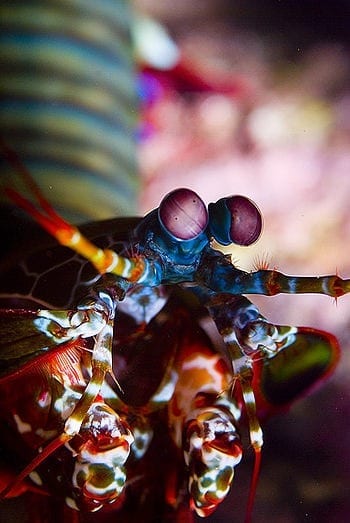
Mantis shrimp eyes are inspiring the design of new cameras that can detect a variety of cancers and visualise brain activity.
University of Queensland research has found that the shrimp’s compound eyes are superbly tuned to detect polarised light, providing a streamlined framework for technology to mimic.
Professor Justin Marshall, from the Queensland Brain Institute at UQ, said cancerous tissue reflected polarised light differently to surrounding healthy tissue.
“Humans can’t see this, but a mantis shrimp could walk up to it and hit it,” he said.
“We see colour with hues and shades, and objects that contrast – a red apple in a green tree for example – but our research is revealing a number of animals that use polarised light to detect and discriminate between objects.
“The camera that we’ve developed in close collaboration with US and UK scientists shoots video and could provide immediate feedback on detecting cancer and monitoring the activity of exposed nerve cells.
“It converts the invisible messages into colours that our visual system is comfortable with.”
Professor Marshall said current scopes and imaging systems used polarised light to detect cancer, but the shrimp-inspired technology aimed to improve and widen these non-invasive detection methods, reducing the need for biopsies and guiding surgical procedures.
The Latest on: Cancer detection
[google_news title=”” keyword=”Cancer detection” num_posts=”10″ blurb_length=”0″ show_thumb=”left”]
via Google News
The Latest on: Cancer detection
- Why Prince William Isn't 'Leaning on Many Others' amid Kate and Charles' Cancer Diagnoses (Exclusive)on May 9, 2024 at 5:00 am
The Prince of Wales' resilience has been tested amid personal turmoil while shouldering his royal responsibilities ...
- ITV This Morning favourite announces cancer diagnosis in emotional confessionon May 9, 2024 at 5:00 am
Lynsey Crombie, known as the Queen of Clean, has opened up about her skin cancer diagnosis and how it has served as a stark reminder of her mortality ...
- Prince William Kicks Off First Overnight Work Trip Since Kate Middleton’s Cancer Diagnosison May 9, 2024 at 4:35 am
The two-day visit marks Prince William's first overnight trip since his wife, Kate Middleton received her cancer diagnosis and began chemotherapy ...
- Sonali Bendre Reveals Husband's Reaction To Her Cancer Diagnosis; Keeping Relationships Strong Through Canceron May 9, 2024 at 4:28 am
Discover Sonali Bendre and husband Goldie Behls journey through cancermdash;a tale of love resilience and strength ...
- Are Much Needed Advances in Early Esophageal Cancer Detection on the Horizon?on May 9, 2024 at 3:00 am
Esophageal cancer remains plagued by a lack of effective techniques to detect early malignancies. Due to this major clinical challenge, esophageal ca | Cancer ...
- Pregnant with pancreatic cancer: How a NJ mom endures a devastating diagnosison May 9, 2024 at 1:31 am
Months before she was due to give birth to her second daughter last year, Jaclyn Lin was eventually diagnosed with stage 4 pancreatic cancer.
- Pioneering liver cancer detection trial in Devonon May 8, 2024 at 9:00 pm
The results will be used to potentially develop a national programme to help diagnose liver cancer at an early stage as the symptoms of the disease are difficult to detect. Around ...
- Experts discuss importance of early detection on World Ovarian Cancer Dayon May 8, 2024 at 7:01 pm
In the U.S., more than 19,680 new cases of ovarian cancer will be diagnosed in 2024. Of those cases, an estimated 12,740 will die, according to researchers.
- EastEnders star Cheryl Fergison on why she "kept quiet" on cancer diagnosison May 8, 2024 at 3:31 pm
EastEnders actor Cheryl Fergison has opened up about why she "kept quiet" about her cancer diagnosis. Cheryl, who played Heather Trott in the BBC One soap between 2007 and 2012, was told she had Stage ...
- Prince Harry Has Been Allegedly Doing This for Kate Middleton Amid Cancer Diagnosis, Sources Claimon May 8, 2024 at 2:00 pm
Despite so many inside sources and insiders claiming Catherine, Princess of Wales, better known as Kate Middleton, and Prince Harry are at odds. We all know that there’s an alleged, ongoing feud ...
via Bing News










